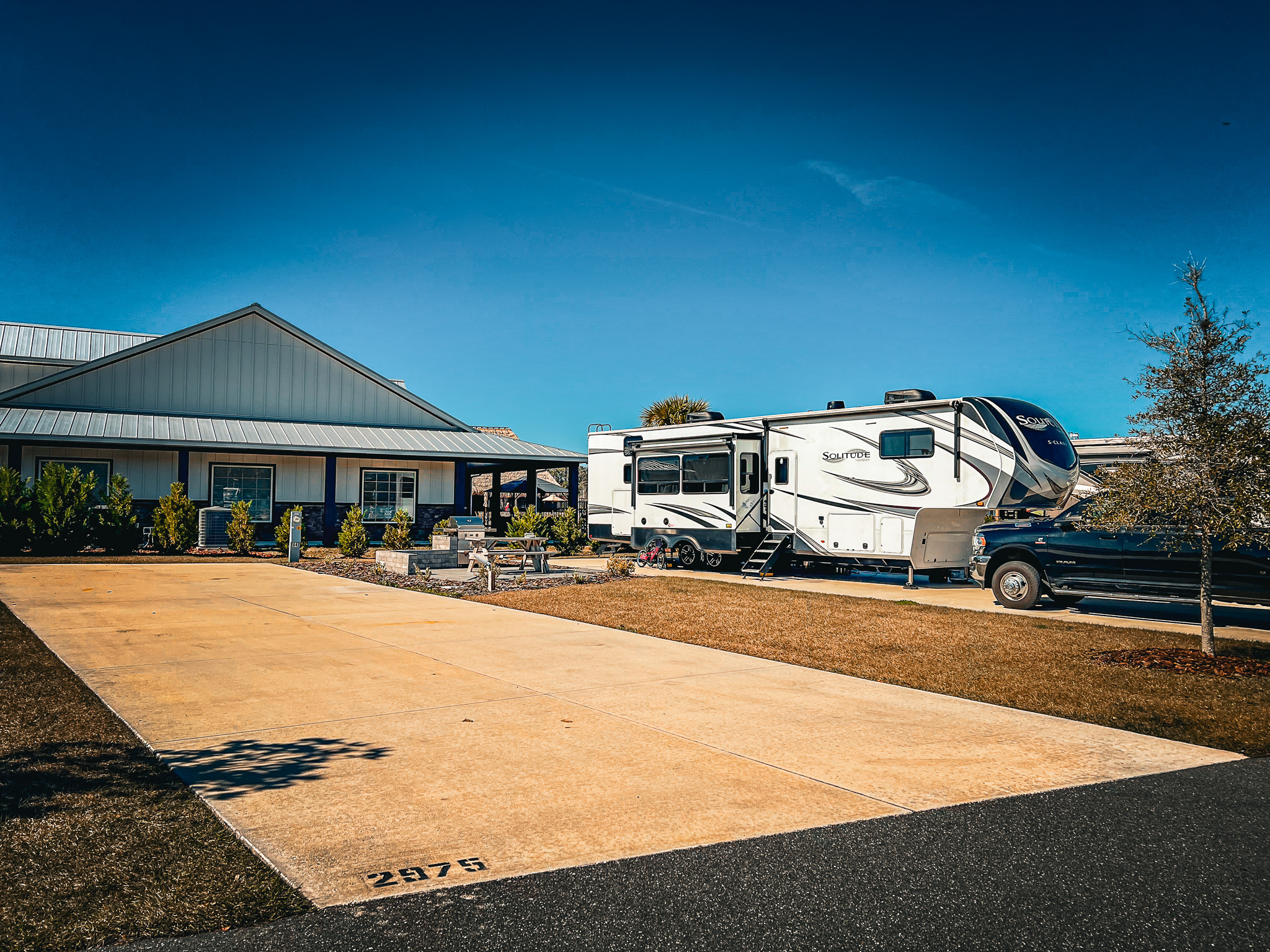We have put together the ultimate RV buying guide for you! If you are interested in a particular section, then jump right to it!
- Introduction: Is RV Life Right for You?
- How Will You Use Your RV?
- Understanding the Different Types of RVs
- New vs Used RV: Pros, Cons, and What to Watch For
- RV Loans & Financing
- Dealer vs Private Seller: Which Is Better for You?
- RV Floor Plans: What Layout Works Best?
- Insurance – What Coverage Do You Really Need?
- Warranties & Extended Service Plans – Are They Worth It?
- RV Maintenance & Ownership Costs
- Final Thoughts & Next Steps
Is RV Life Right for You?
The dream of hitting the open road, chasing sunsets, and waking up in new places is drawing more people than ever into the world of RV travel. Whether you’re craving weekend getaways, planning a full-time nomadic lifestyle, or just want to travel more affordably, RVing offers freedom, flexibility, and a deep connection to nature and community.
But before you start shopping for your perfect rig, it’s worth asking yourself: Is RV life right for me?
It’s More Than a Vacation – It’s a Lifestyle Shift
RV ownership isn’t just about the camper you buy, it’s about how you plan to use it and the lifestyle it unlocks. From exploring national parks to boondocking off-grid or making weekend escapes to your favorite lakeside campground, there are endless ways to enjoy your RV. But it also comes with trade-offs: smaller living spaces, more maintenance, and a new set of logistics to manage.
Some people find it thrilling. Others… not so much.
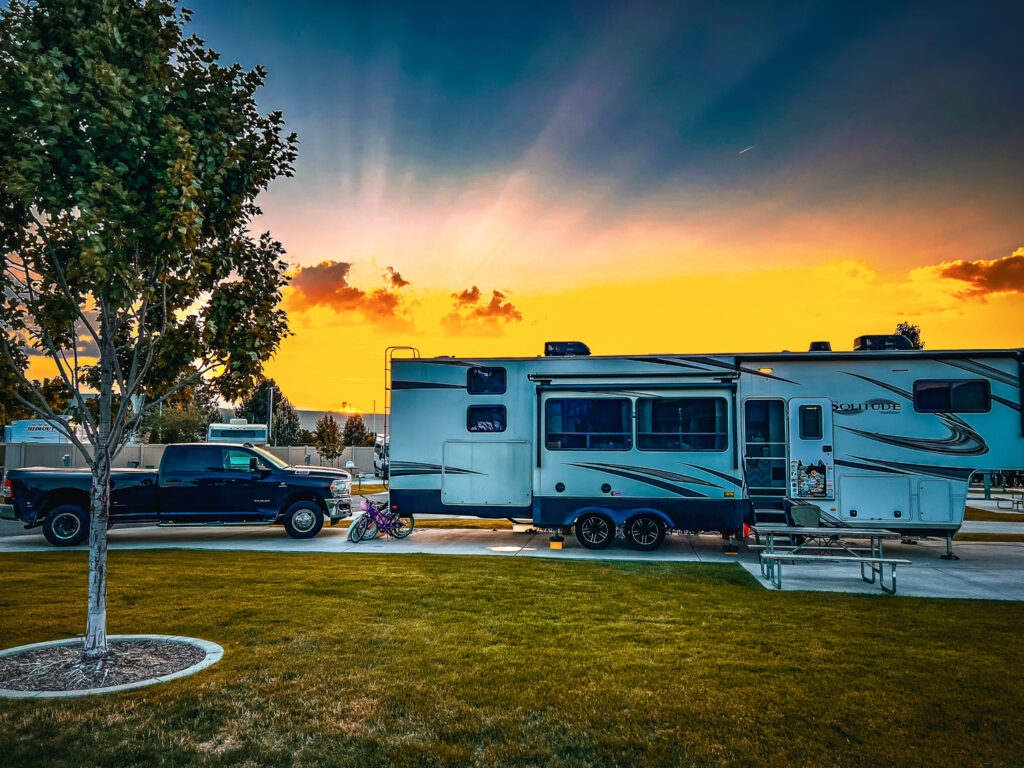
Who RV Life Works Best For
Here are a few examples of who thrives in the RV lifestyle:
- Weekend Warriors who want to escape the 9–5 grind and make the most of their free time.
- Retirees seeking adventure without giving up the comforts of home.
- Families who want to show their kids the country and spend quality time together.
- Remote Workers trading in office walls for scenic views and mobile Wi-Fi setups.
- Full-Time Travelers who crave freedom, minimalism, and the flexibility to go wherever life takes them.
If you see yourself in any of these groups, or aspire to be, you’re in the right place.
What This Guide Will Help You Do
Buying an RV is a big decision, and with so many types, layouts, and financial options to choose from, it can be overwhelming. This guide breaks down everything you need to know:
- How to choose the right RV type for your lifestyle
- What to consider when buying new vs used
- How to set a realistic budget (and stick to it)
- Tips for RV loans and financing
- What to inspect before you buy
- Must-have gear, maintenance tips, and more
By the end of this guide, you’ll feel confident, informed, and ready to make a decision that fits your travel goals, whether you’re buying your very first RV or upgrading to your dream rig.
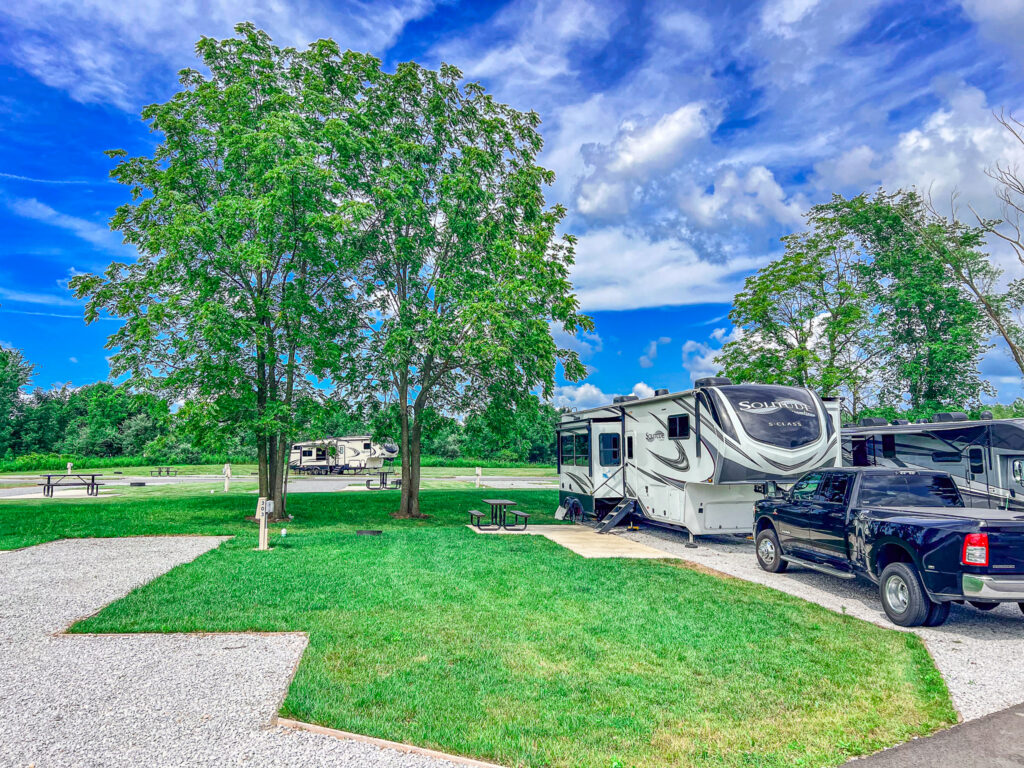
How Will You Use Your RV?
Before you even step foot on a dealership lot or browse RV listings online, you need to answer one key question:
What kind of RV lifestyle do you want to live?
The way you plan to use your RV plays a major role in determining what type of rig is right for you. An RV built for weekend trips to a local campground will look very different from one designed for full-time off-grid living.
Weekend Warrior or Full-Time Traveler?
Ask yourself:
- Are you planning to use the RV for short getaways or long cross-country trips?
- Will you be traveling seasonally or living in it year-round?
- Do you need to work remotely while on the road?
- Will you be boondocking (camping without hookups) or sticking to campgrounds with full hookups?
Knowing how you’ll use your RV helps you prioritize features like:
- Storage space (important for long trips or families)
- Off-grid capabilities (solar panels, large water tanks, etc.)
- Sleeping arrangements (do you need bunk beds, convertible dinettes, or a dedicated bedroom?)
- Size and maneuverability (larger rigs are great for comfort but harder to drive and park)
Who Will Be Traveling With You?
Consider your travel crew:
- Solo traveler? A Class B camper van or small trailer might be all you need.
- Couple? Look for a cozy, comfortable layout with seating and a queen bed.
- Family? You’ll need sleeping space for everyone and ideally some separation for sanity!
Also think about pets, guests, or anyone else who may occasionally travel with you.
Where Will You Camp?
Your preferred camping style impacts your needs:
- Campground Camping: You’ll likely have full hookups, so power and tank sizes aren’t as critical.
- Boondocking or Dry Camping: You’ll want solar, larger tanks, and more battery capacity.
- National Parks: These parks often have size restrictions. Many limit RVs to under 35 feet, but for the most part, you can find spots for 40 foot rigs.
Understanding your unique RV goals early will save you time, money, and buyer’s remorse. Up next, we’ll break down the types of RVs and how to choose one that matches your travel style.
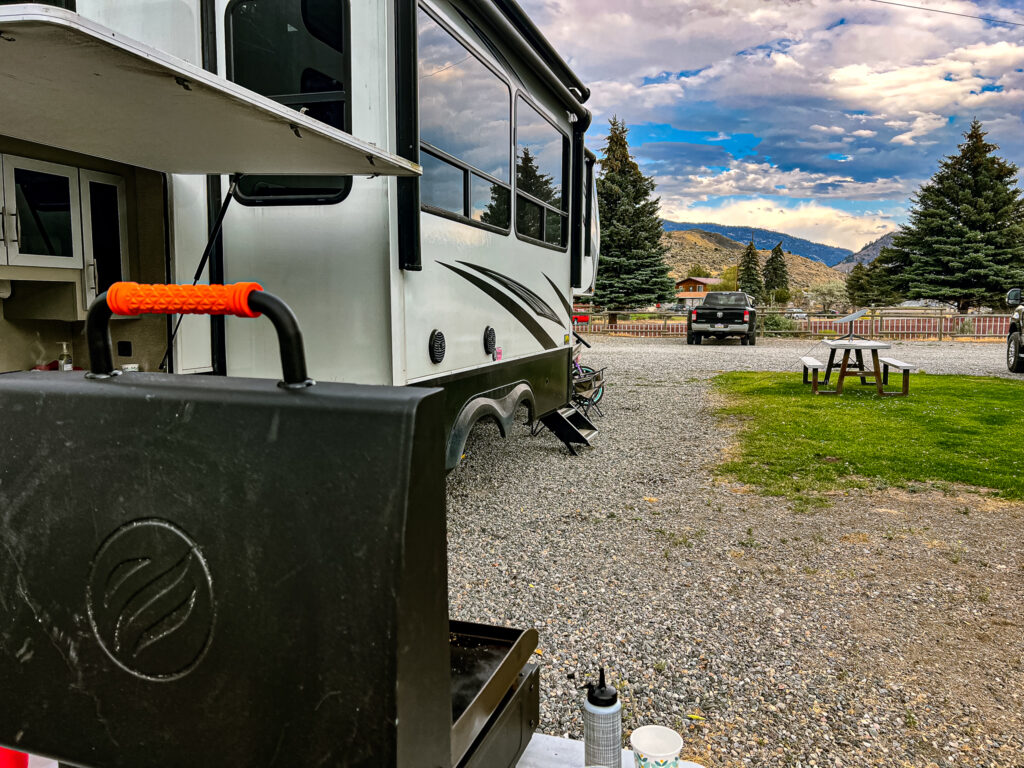
Understanding the Different Types of RVs
One of the first big decisions you’ll make is choosing what type of RV is right for you. The RV world is full of options, from compact camper vans to massive diesel pushers, and each one comes with its own pros, cons, and ideal use.
Here’s a plain-English breakdown of the most common RV types to help you figure out what best fits your travel lifestyle.
Class A Motorhomes
What they are…
The biggest, most luxurious motorhomes on the road. Think tour bus.
Pros:
- Tons of space and storage
- Often include full kitchens, washer/dryers, and residential-style amenities
- Great for full-time living or long trips
Cons:
- Can be very expensive
- Will also need to have a second vehicle to be able to drive to grocery stores or to do tourist activities.
Class B Camper Vans
What they are:
Compact vans outfitted for camping. They are great for solo travelers or minimalist couples.
Pros:
- Easy to drive and park (can fit in a standard parking space)
- Great fuel economy
- Stealth camping is possible
Cons:
- Small space, limited storage
- Often higher cost per square foot
Class C Motorhomes
What they are:
Mid-size RVs with a van/truck cab and an overhead bunk.
Pros:
- More affordable than Class A
- Easier to drive than a bus-style rig
- Great mix of space and mobility
Cons:
- Smaller than a Class A typically, but still larger than a parking spot, so will likely still need a separate car to travel around town with.
Travel Trailers (Towable)
What they are:
RVs you tow behind a vehicle that are available in many lengths and layouts. Generally called a “bumper pull”
Pros:
- Huge variety of floorplans
- Can unhook and use your tow vehicle separately
- Lower upfront cost than motorhomes
Cons:
- Towing adds complexity
- Requires a capable tow vehicle
Fifth Wheels
What they are:
Towable RVs that hitch into the bed of a truck (not bumper-towed).
Pros:
- Very spacious with multiple slide-outs
- More stable tow than travel trailers
- Luxurious layouts with residential feel
Cons:
- Requires a truck with a fifth-wheel hitch
- Can’t use the truck bed for much else
Toy Haulers
What they are: Trailers or fifth wheels with a built-in garage for ATVs, motorcycles, etc.
Pros:
- Great for adventure gear or extra sleeping space
- Rear ramp doubles as a patio on some models
Cons:
- Heavier and more expensive
- Floor plans sacrifice some living space
Pop-Up Campers & Hybrids
What they are:
Lightweight, collapsible trailers or hybrids with pop-out tent areas.
Pros:
- Budget-friendly
- Easy to tow
- Fits in small driveways
Cons:
- Limited insulation and weather protection
- Set-up and breakdown can be tedious
Not sure which one is right for you? Don’t worry, we’ll help you figure that out based on your travel goals, budget, and lifestyle in the next few sections.
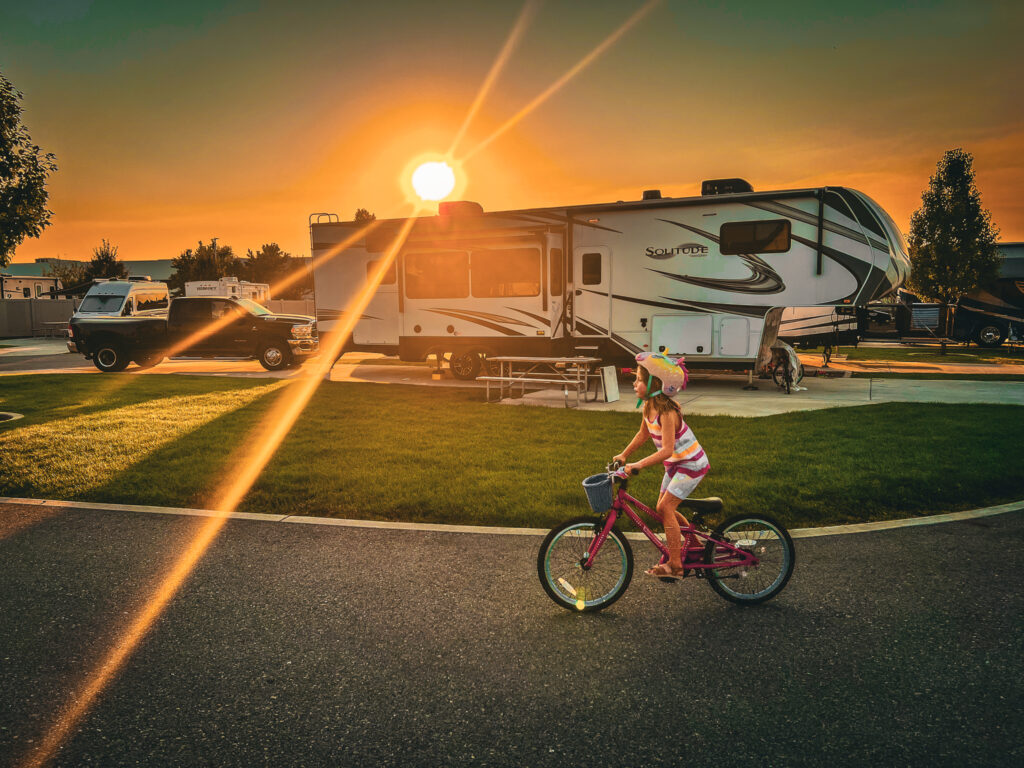
New vs Used RV: Pros, Cons, and What to Watch For
One of the biggest decisions you’ll face early on is whether to buy a new RV or a used one. Both options come with advantages and trade-offs. Your decision will depend on your budget, experience level, and comfort with potential repairs or maintenance.
Let’s break it down:
Buying a New RV
Pros:
- Warranty coverage: Most new RVs come with manufacturer warranties for at least 1–2 years, giving you peace of mind.
- Latest features: You’ll get modern layouts, up-to-date appliances, USB ports, solar prep, and other trending upgrades.
- No hidden wear-and-tear: You’re the first owner, so no surprises from previous misuse or poor maintenance.
- Dealer perks: Some dealerships offer free orientation, service packages, or first-year inspections.
Cons:
- Depreciation hits fast: Much like a new car, your RV’s value drops significantly the moment you drive it off the lot.
- Higher cost upfront: New RVs are considerably more expensive than similar used models.
- Potential for “shakedown” issues: Oddly enough, brand-new RVs sometimes have more little problems at first due to factory rush jobs or transit damage.
New RVs are best for buyers who want warranty peace of mind, modern features, and less risk of the unknown, especially first-timers who want dealer support.
Buying a Used RV
Pros:
- Lower purchase price: You can save thousands by letting someone else take the depreciation hit.
- More negotiating power: Private sellers are often flexible on price.
- Can upgrade smartly: You can modify and upgrade with the money you saved.
- Real-world reviews: You can find honest feedback on specific models from owners online (and avoid known issues).
Cons:
- Maintenance unknowns: You might be buying someone else’s problems if the RV wasn’t well cared for.
- No warranty: Unless you purchase an extended warranty, you’ll be paying for repairs out of pocket.
- Outdated features: You may need to modernize appliances, entertainment systems, or decor.
- Harder financing: Loans for older RVs (10+ years) may be more limited or have higher interest rates.
Used RVs are best for budget-conscious buyers, DIYers, or anyone looking to avoid rapid depreciation.
What to Watch for in a Used RV
If you go the used route, be sure to:
- Inspect the roof for signs of water damage or patches.
- Check all seals and slide-outs for proper function.
- Look under sinks and in corners for mold or moisture.
- Test every system: A/C, fridge, heat, water, outlets, plumbing, etc.
- Ask for maintenance records and ownership history.
- Hiring an RV inspector is a great idea!
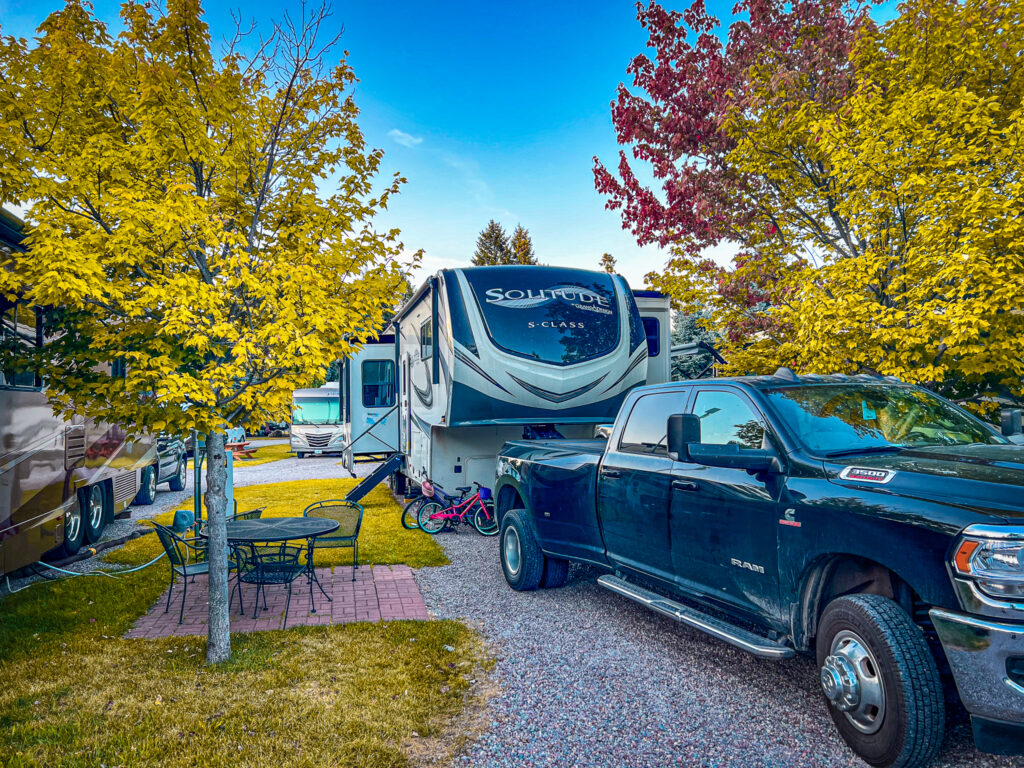
RV Loans & Financing Options
Unless you’re paying with cash, financing your RV is a big part of the buying journey. RV loans are different from car loans in both structure, qualification and whether you’re buying a tiny pop-up camper or a luxury Class A motorhome, so it helps to understand what your options are.
Types of RV Loans
1. RV Loans Through Banks or Credit Unions
- Traditional financing with competitive interest rates.
- Many credit unions offer dedicated RV financing programs.
- Terms range from 5 to 20 years, depending on loan amount and creditworthiness.
2. Dealer Financing
- Convenient, but sometimes comes with higher rates or hidden fees.
- Dealers often mark up the rate for extra profit, so always compare rates elsewhere.
3. Online RV Loan Lenders
- Companies like My Financing USA specialize in RV loans for both part-timers and full-timers.
- Great for those with less-than-perfect credit or unique situations.
4. Personal Loans
- May work for smaller RVs or travel trailers under $10k.
- Typically have shorter terms and higher interest rates than secured loans.
Credit Requirements
Your credit score will impact:
- Your loan approval
- The interest rate
- The required down payment
Excellent credit (700+):
- Qualify for best rates (5–7%)
- Down payments as low as 10%
Fair credit (600–700):
- Higher rates (8–12%) and larger down payment
Poor credit (below 600):
- May require a co-signer or specialized lender
- Expect interest rates above 12–15%, if approved
Note: RVs are considered “luxury items” so approval is generally stricter than for cars.
Full-Time vs Part-Time RV Loans
Many lenders won’t finance full-time RVers because of insurance and residency concerns. If you plan to live in your RV:
- Be upfront with lenders and look for full-timer friendly loan providers.
- Ensure your insurance covers full-time use too!
Pro Tips
- Get pre-approved before shopping to know your budget.
- Use loan calculators to model different scenarios.
- Factor in total cost of ownership, not just the monthly payment.
- Don’t forget about RV insurance, which is typically higher than auto insurance.
When financing is done right, it opens the door to more freedom on the road without financial strain. But it pays to do your homework, especially when it comes to rates, terms, and full-time RV eligibility.
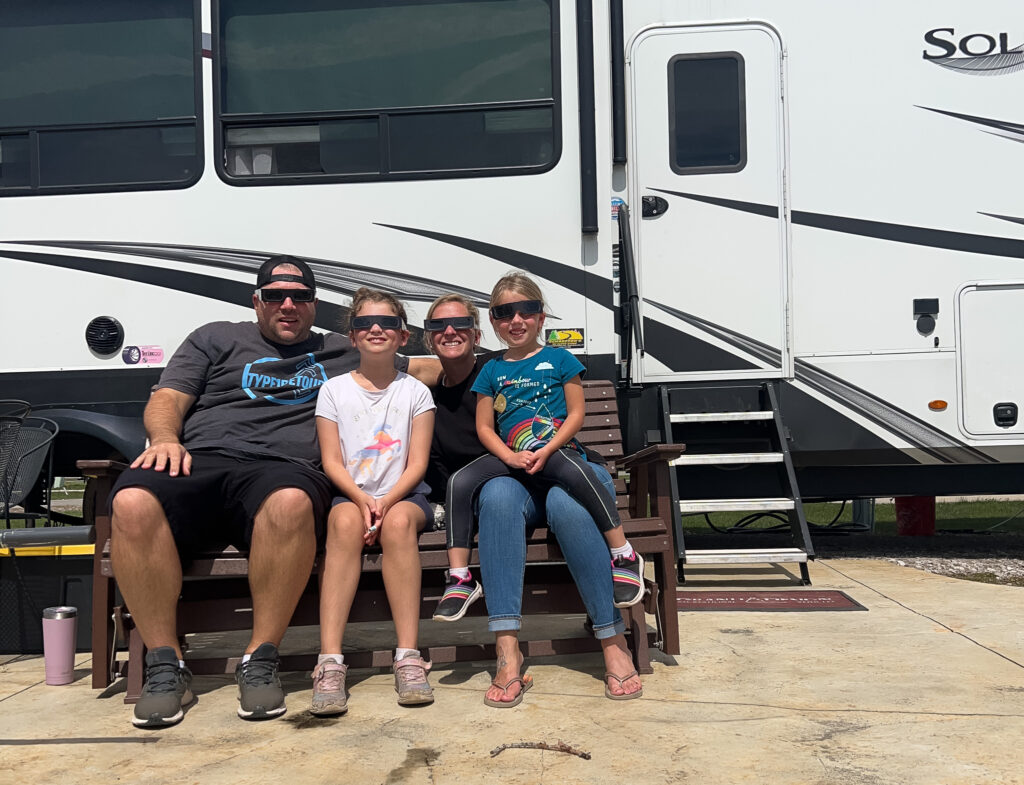
Dealer vs Private Seller: Which Is Better for You?
One of the biggest decisions you’ll face during the RV buying process is where to buy your RV. Both dealerships and private sellers offer advantages—and potential pitfalls. The best choice depends on your budget, experience, and comfort level with negotiation and inspections.
Buying from an RV Dealer
Pros:
- More inventory to browse: Walk through dozens of rigs in one visit.
- Financing options available: Dealers often work with banks and credit unions.
- Warranties and service plans: New RVs come with manufacturer warranties; used RVs may have service contracts.
- Trade-ins accepted: Easy to swap out your current rig.
- Walk-throughs & training: Many dealers offer delivery day orientations.
Cons:
- Higher prices: You’ll likely pay more than private party prices.
- Pressure to upsell: Add-ons, extended warranties, and financing can all increase the cost.
- Dealer prep fees: Can add $1,000–$3,000+ on top of the sticker price.
- Less room to negotiate: Especially with new RVs.
Buying from a Private Seller
Pros:
- Lower prices: No RV dealership markup.
- More negotiation power: Motivated sellers are often flexible.
- Know the RV’s history: Private sellers can (hopefully) give honest details about past use and issues.
- No hidden dealer fees.
Cons:
- No warranty: You’re buying “as-is.”
- Financing is trickier: You’ll need to arrange a personal loan or RV loan separately.
- No prep or inspection included: You’ll need to schedule your own PDI (Pre-Delivery Inspection).
- More risk of hidden problems: Especially if you don’t know what to look for.
🤝 Which One Should You Choose?
| You Might Prefer… | If You Want… |
| A Dealer | Peace of mind, service plans, in-house financing, lots of inventory |
| A Private Seller | A lower price, flexible negotiation, and are comfortable with DIY research |
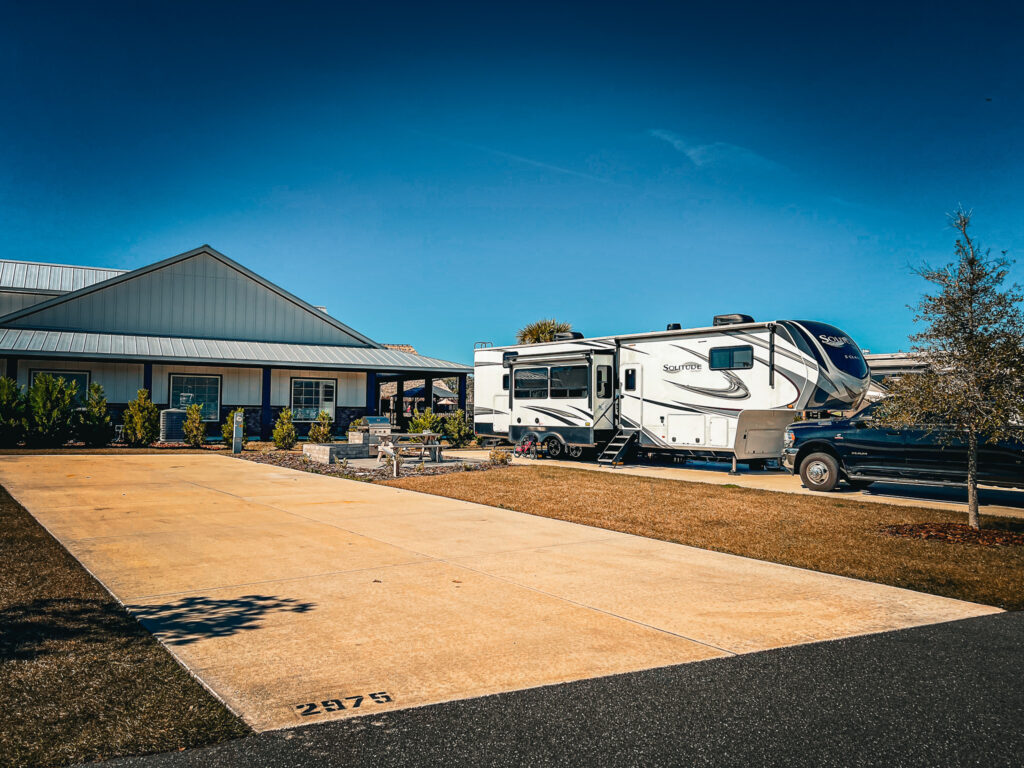
RV Floor Plans – What Layout Works Best for Your Lifestyle?
Not all RVs are created equal and floor plans are where the biggest differences shine. Whether you’re a solo traveler, a couple, or a family of five, the layout of your RV can make or break your camping experience.
What to Consider When Choosing a Floor Plan
Before you fall in love with that stylish kitchen island or big-screen TV, consider:
- How many people will sleep in the RV regularly?
- Do you need dedicated work or school space?
- How often will you cook meals inside?
- Do you want more open space or more separation between rooms?
- Will you need indoor space during bad weather or remote work days?
Common RV Floor Plan Features to Know
| Feature | Why It Matters |
| Slide-outs | Add significant interior space when parked, especially in living or dining areas. |
| Bunkhouses | Great for families with kids, offering extra sleeping and play space. |
| Rear Living vs Rear Kitchen | Rear living often includes large windows and comfortable seating; rear kitchen offers more countertop space. |
| Mid-bath vs Split Bath | Split baths allow simultaneous use; mid-baths often feel more residential. |
| Loft Areas | Found in larger fifth wheels or toy haulers, good for kids or extra storage. |
| Murphy Beds | Offer space-saving solutions in smaller RVs (fold-down beds). |
| Dinette Booths vs Freestanding Tables | Dinette booths convert into sleeping space; freestanding tables feel more “homey.” |
Pro Tips for Choosing the Right Floor Plan
- Walk through it in person – Stand in the shower, sit on the couch, open the fridge and pantry.
- Bring your family – Make sure everyone has space to relax and sleep.
- Imagine a rainy day inside – Could you all function comfortably if you had to stay in for 24 hours?
- Think about privacy – For families, separate bedrooms or curtains help avoid feeling cramped.
- Storage, storage, storage – Look for hidden compartments, under-bed storage, and kitchen cabinetry.
The right floor plan feels like it was made for your lifestyle. Don’t get distracted by aesthetics alone. Focus on comfort, function, and how you plan to live in the space.
Inspection Checklist – What to Check Before You Buy
Whether you’re buying new or used, inspecting the RV thoroughly before finalizing the deal is non-negotiable. This isn’t like buying a car. You’re purchasing a vehicle, a tiny home, and a complex electrical and plumbing system all in one. A solid inspection could save you thousands of dollars and countless headaches down the road.
What to Bring With You
Before you head to the dealership or seller’s home, bring:
- A flashlight
- Moisture meter
- Notepad or checklist
- Camera (or phone with video)
- A trusted RV-savvy friend (if you can)
Exterior Inspection
- Roof – Look for cracks, soft spots, or failing seals. Walk it if possible.
- Sidewalls – Check for delamination, bubbling, or unusual discoloration.
- Windows & Seals – Look for dried-out seals, gaps, or leaks.
- Storage Bays – Ensure they open, close, and lock properly.
- Tires – Check the DOT date. Tires over 5-6 years old should be replaced, even if they look fine.
- Slides – Inspect seals and ask to extend/retract them fully.
- Awning – Look for tears, mold, and test the motor (if powered).
- Undercarriage – Scan for rust, rodent nests, or leaks.
Interior Inspection
- Ceiling & Corners – Feel for soft spots or signs of water intrusion.
- Floors – Walk around and press for spongy areas.
- Cabinetry & Walls – Open every cabinet, check hinges, and look behind them for mold.
- Appliances – Test fridge, stove, microwave, AC, and furnace.
- Plumbing – Run sinks, flush toilet, check under for leaks.
- Electrical – Test outlets, light switches, and monitor panels.
- Furniture – Look for excessive wear or signs of water damage.
Systems Check
- Battery and Converter – Ensure the 12V system is powering lights and water pump.
- Inverter (if installed) – Check that it converts power properly.
- Water Heater – Turn it on with propane and electric.
- Furnace & AC – Run each for at least 10 minutes.
- Slide-Outs – Open and close fully. Listen for grinding or sticking.
- Leveling Jacks – Test their extension and retraction.
Bonus: Professional Inspection
If you’re buying a used RV (or even an expensive new one), hiring a certified NRVIA inspector is a smart move. These professionals will give you a full inspection report and may catch things you’d never think to look for.
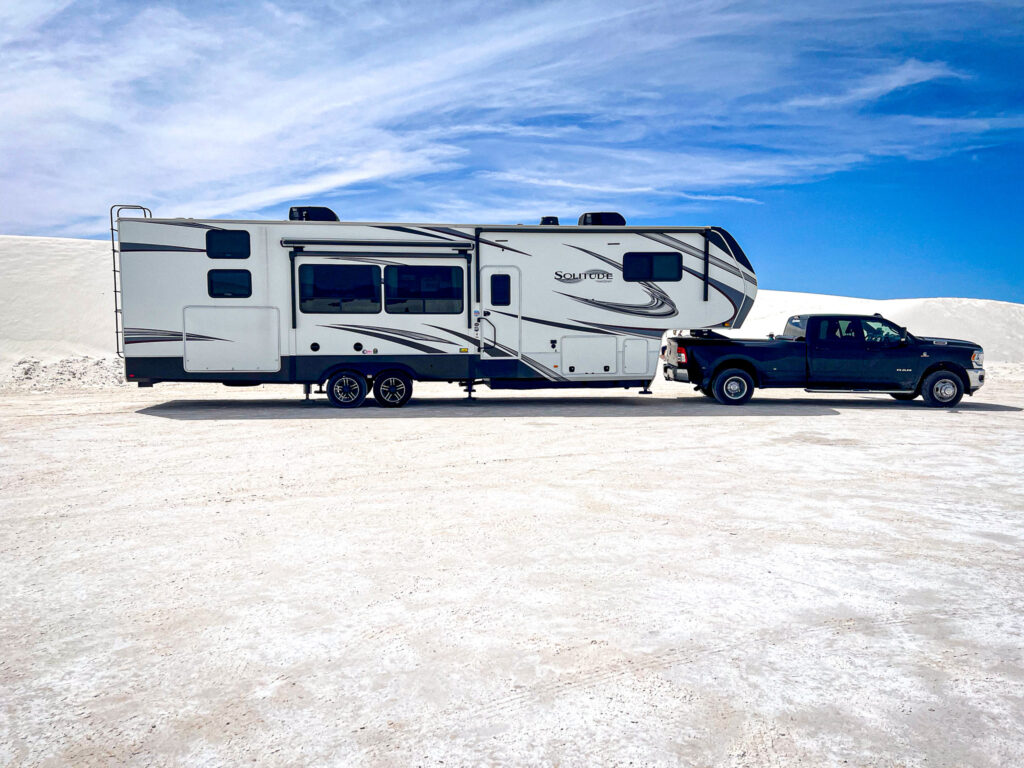
Insurance – What Coverage Do You Really Need?
Just like any big investment, your RV needs insurance. But RV insurance isn’t one-size-fits-all and it’s definitely not the same as standard auto insurance. Your coverage needs will depend on your rig type, usage, and whether you’re a weekend warrior or full-time traveler.
What Is RV Insurance?
RV insurance is a specialized type of policy that covers your motorhome or travel trailer. It typically includes a mix of auto and homeowner-style protections, depending on how you use your RV.
Types of Coverage to Consider
Here are the most common types of RV insurance coverage:
- Liability – Covers damage you cause to others (mandatory in all states for motorhomes).
- Comprehensive & Collision – Protects your RV from damage (accidents, weather, theft, etc.).
- Uninsured/Underinsured Motorist – Protects you if the other driver doesn’t have enough coverage.
- Vacation Liability – For stationary use when you’re parked at a campground.
- Full-Timer Liability – Replaces homeowner’s insurance if you live in your RV full-time.
- Personal Belongings – Covers your stuff inside the RV (electronics, clothing, tools, etc.).
- Roadside Assistance – Towing, flat tires, lockouts, and battery jumps.
- Total Loss Replacement or Agreed Value – Protects against depreciation with better replacement value options.
Insurance for Full-Time RVers
If your RV is your only residence, you’ll need full-timer coverage which provides broader liability protection, more like a homeowner’s policy. Standard policies won’t cover full-time living risks like extended stays or theft of personal items while parked.
Be upfront with your insurance company about full-time status. If you make a claim and you’ve been living in your RV full-time under a standard policy, it could be denied.
Insurance for Towable RVs (Trailers, Fifth Wheels)
These require a slightly different approach:
- The tow vehicle is typically covered by your auto insurance.
- The trailer needs its own comprehensive/collision coverage.
- Liability is usually extended from your tow vehicle while driving, but not when parked. That’s where vacation liability or campsite liability comes in.
Factors That Affect Your RV Insurance Rates
- Type and class of RV (Class A, B, C, travel trailer, etc.)
- Age and condition of the RV
- Location/where it’s stored
- Usage: Full-time vs. part-time
- Driving record
- Credit score
- Claim history
Warranties & Extended Service Plans – Are They Worth It?
Once you’ve picked the perfect RV, you’ll likely be offered extended warranties or service contracts, and for good reason. RVs are complex machines, and repair costs can be steep. But not all warranties are created equal, and it’s essential to understand what you’re buying.
What Is an RV Warranty?
An RV warranty is a promise by the manufacturer (or a third-party provider) to cover the cost of certain repairs or replacements for a defined period of time.
- Manufacturer Warranty: Comes standard with a new RV. Covers major components like the engine (motorhomes), appliances, and structural integrity (usually for 1 to 3 years.)
- Extended Warranty / Service Contract: Optional add-on that extends coverage beyond the manufacturer warranty. These are typically offered by dealerships or third-party providers.
What Does an Extended RV Warranty Cover?
Coverage varies widely, but most extended service plans include:
- Appliances (fridge, water heater, A/C, furnace)
- Electrical systems
- Plumbing systems
- Slide-outs and leveling jacks
- Generators
- Engine and drivetrain (for motorhomes)
Some plans offer comprehensive (exclusionary) coverage. These cover everything except what’s specifically excluded. Others are named component plans and they only cover items listed in the contract.
Always read the fine print. Some plans exclude high-use items like seals, gaskets, or labor costs.
Are Warranties Worth the Cost?
Pros:
- Peace of mind if something expensive breaks
- Can protect against unexpected repair costs
- May include added perks like roadside assistance or trip interruption coverage
Cons:
- High upfront cost (can be $2,000–$8,000+)
- Many repairs might not be covered
- Claims process can be slow or denied
- You may never use it, especially if your RV is newer or lightly used
Questions to Ask Before Buying
- Is it transferable if I sell the RV?
- Is there a deductible?
- Are there limits on where I can have repairs done?
- Can I cancel and get a refund if I change my mind?
- Are claims paid directly to repair shops, or do I have to pay upfront?
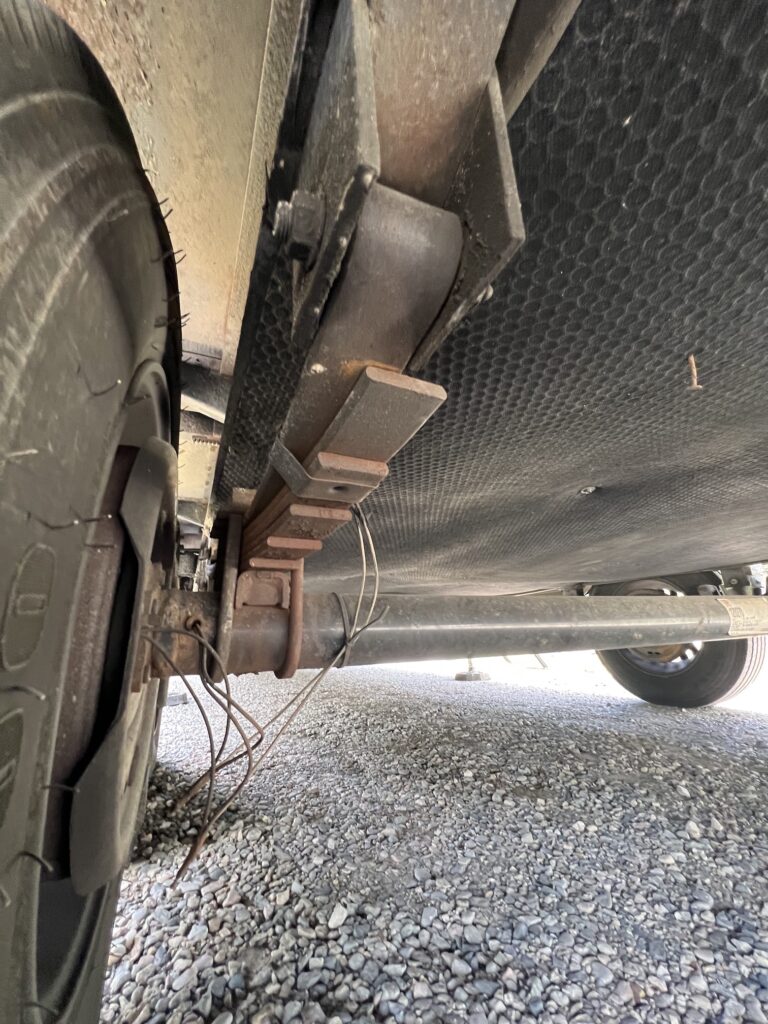
RV Maintenance & Ownership Costs – What to Expect After You Buy
Buying an RV is just the beginning. Ownership comes with ongoing maintenance, unexpected repairs, and a few surprise costs you may not have considered. Whether you’re a weekend warrior or a full-timer, knowing what to expect can help you budget smarter and avoid headaches down the road.
Routine Maintenance
Just like a car or house, your RV needs regular upkeep. Here’s what to plan for:
- Oil changes & engine maintenance (for motorhomes)
- Roof inspections & resealing (typically once or twice a year)
- Tire checks and rotations
- Battery maintenance
- Slide-out lubrication
- Winterizing & de-winterizing
- Air conditioner cleaning & filter replacement
- Appliance servicing (fridge, water heater, etc.)
Tip: Set a recurring calendar reminder for key seasonal maintenance items like roof checks and winterization.
Common Annual Costs (Estimates)
These costs can vary based on your RV type, usage, and where you travel or store it.
| Expense | Estimated Annual Cost |
| Routine Maintenance | $500–$1,500 |
| Tires (every 3–6 years) | $800–$2,500 (for full set) |
| Insurance | $300–$1,500 |
| Registration & Taxes | $100–$1,200+ (varies by state) |
| Storage (if not at home) | $300–$1,800 |
| Repairs & Breakdowns | $500–$2,000+ (varies widely) |
| Campground Fees (if applicable) | $1,500–$6,000+** |
Keep an RV emergency repair fund of at least $1,000–$2,000 available at all times.
**Thousand Trails can help save you thousands of dollars!
Unexpected Expenses to Watch For
- Slide or awning motor failures
- Water damage or roof leaks
- Electrical shorts or converter issues
- Broken appliances
- Leveling system malfunctions
- Black tank clogs or valve problems
Even new RVs can experience issues early on. Always inspect your RV regularly and don’t ignore small signs of trouble.
Cleaning and Care
Keeping your RV clean isn’t just for looks. It also protects your investment. Consider the following:
- Exterior washing & waxing
- Roof cleaning
- Interior deep cleans (especially before/after storage)
- Mold/mildew prevention
- Water system sanitization (seasonally)
Long-Term Ownership Costs
Over time, budget for:
- Battery replacements (every 3–7 years)
- New tires
- Upholstery or flooring refresh
- Technology upgrades (WiFi boosters, new TVs, solar, etc.)
- Potential resale repairs or prep work
Final Thoughts & Next Steps – Confidently Buying the Right RV for You
Purchasing an RV isn’t just a transaction, it’s a lifestyle shift. Whether you’re dreaming of weekend getaways or preparing to go full-time on the road, making the right decision up front will save you time, money, and stress down the line.
Don’t Rush – Do Your Research
Take your time exploring all your options:
- Visit RV shows and walk through various layouts.
- Rent different RV types to test what fits your travel style.
- Join RV forums and Facebook groups to hear real-world experiences.
- Talk to RV owners, especially ones who use theirs similarly to how you plan to.
Every RV buyer is different. Your priorities might not match someone else’s, and that’s okay. This guide helps you understand your own needs, so you don’t get swayed by flashy features or high-pressure sales.
Recap Checklist
Here’s a quick recap of the main things to keep in mind before buying:
✅ Know how you’ll use the RV
✅ Choose the right type and layout for your lifestyle
✅ Understand financing options and create a realistic budget
✅ Decide between new vs used
✅ Do a full inspection and check for red flags
✅ Budget for maintenance and storage
✅ Think about where you’ll camp and travel
✅ Ask lots of questions and trust your gut
You’re Ready to Hit the Road
The RV lifestyle offers freedom, adventure, and connection, but only if you make a purchase that truly fits your needs. With this guide, you’ve taken a huge step toward buying smart, camping confidently, and making the most of every mile.
See you out there on the open road and Create Your Own Detour!
